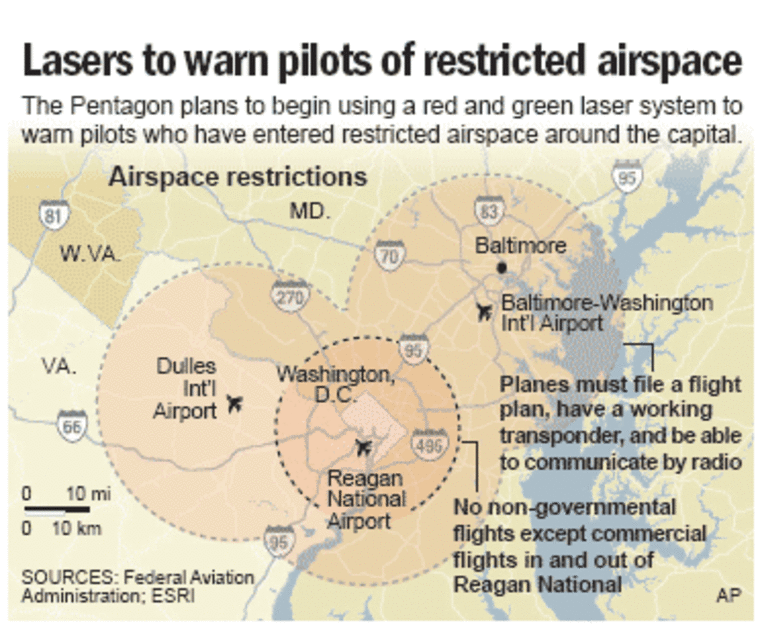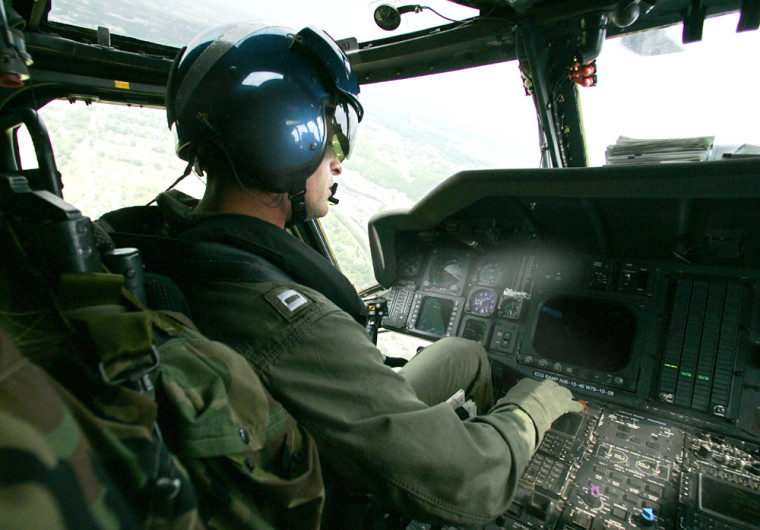From 1,500 feet above southeast Washington on a hazy Tuesday, you didn’t have to look hard to notice a bright red-and-green flashing light among the clutter of treetops, rooftops, the Washington Monument and the Capitol.
That’s the idea. When pilots see the light, it means they’ve flown into restricted airspace. They are to fly away from the light — fast — and contact air traffic control.
The Pentagon took reporters up in helicopters to showcase the system of green-and-red laser beams scattered around the capital. It will become operational Saturday.
“We’ve got to educate the flying community out there on this very simple, very safe system,” said Col. Ed Daniel, vice commander for the 1st Air Force in the Continental United States NORAD Region.
Memories of last week's near tragedy
The goal is to avoid what happened last week, when the pilot of a small plane became disoriented and flew within three miles of the White House, prompting frantic evacuations of tens of thousands of people. President Bush was away at the time, but Vice President Dick Cheney and first lady Laura Bush were rushed from the White House and F-16s escorted the aircraft to a nearby airport.
People can get hurt in mass evacuations, and an innocent pilot can get shot down just because he loses his way and flies too close to the White House.
According to NORAD — the North American Aerospace Defense Command — it costs between $30,000 and $50,000 just to scramble a single fighter jet.
Federal officials see the laser system as a far cheaper way to warn pilots.

Private planes are not allowed to fly in the Air Defense Identification Zone — an area of about 2,000 square miles radiating from the three airports around Washington — unless they have a special transponder code and maintain radio contact with the FAA.
They’re not allowed at all within the Flight Restricted Zone, about a 16-mile radius around the Washington Monument.
Despite efforts to educate pilots about the restricted airspace since the Sept. 11 terrorist attacks, hundreds have flown into it.
Skepticism gives way to support
The idea of using lasers initially drew some resistance because they’ve been beamed into cockpits — either inadvertently or by pranksters — more than 100 times since last November. Federal officials have warned that terrorists might use the beams of light to blind pilots as they approach airports.
The Aircraft Owners and Pilots Association, an advocacy group for 404,000 private pilots, was initially skeptical about the laser system. It finally endorsed it as not bright enough to be blinding or excessively distracting. Now the group is working to educate its members about the laser warning system.
AOPA spokesman Chris Dancy said he received hundreds, if not thousands, of e-mails from members who were furious at the two pilots who had strayed into the Washington airspace.
“They were very pleased there was no shootdown,” Dancy said. “They thought they deserved to be punished but they didn’t deserve to die for it.”
Better radar
The laser system is possible because radar coverage has been enhanced significantly since the Sept. 11 attacks.
When radar picks up an unauthorized aircraft flying into the ADIZ, air traffic controllers will try to make radio contact with the pilot. If that fails, a person sitting at a computer at a fusion center will click a mouse, activating the laser nearest the errant plane.
The laser beam will only hit the plane it’s intended to warn.
“If you see the light, you’re the person we’re trying to contact,” Daniel said.
